Blues Reviews Aug/Sept 2020
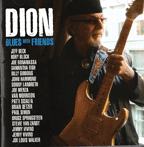 Dion
Dion
Blues with Friends
Keeping the Blues Alive Records 2020
By my count this is Dion DiMucci’s 41st album…but who’s
counting? It wouldn’t surprise me if he kept on truckin’ for
at least another decade, into his nineties. His voice sure shows no sign
of flagging.
A New York City native, Dion was singing on street corners in his teens
and then leading the iconic pop group Dion and the Belmonts in the late
1950s, melding rock and doo-wop into a potent mix. The sixty (!) years
since he went solo have produced further chart-topping hits and a slew
of lauded albums. In the last few years he has returned wholeheartedly
to his blues roots. This outing finds him paired on the songwriting front
with buddy Mike Aquilina, and in the studio with multi-instrumentalist
(and co-producer) Wayne Hood, who plays guitars, bass, keyboards, and
drums as Dion plays occasional guitar and sings.
Boy, does he sing! Let it be said out front that he has one of the finest
voices in contemporary music – all genres of music: deep, smooth,
soulful, with wide range, and with perfect pitch. Although he looks about
sixty in his photos, he is eighty-one, and I didn’t expect to hear
him still sound like a twenty-year-old…but he does.
The set of fourteen original songs, clocking in at an hour, spans a gamut
from pure rock to traditional twelve-bar blues to gospel to slow late
night bar crooning. His startlingly impressive cast of guests is well
chosen to bolster the various tracks while mining their own individual
strengths. No guest is wasted here; each contributes her or his skill
set while Dion’s voice remains the focus. The set commences with
“Blues Comin’ On,” a song that Dion allegedly previewed
for Joe Bonamassa, who wanted to play on it…and does so successfully,
reining in his sometime extravagance with the result being a top-flight
blues rocker. Dion was so stoked by the result that he called up other
friends, and the rest is now history.
There is no inferior track, but some stand out. “Uptown Number 7,”
with Brian Setzer on guitar, is another irresistible rocker with a decided
gospel vibe. “My Baby Loves to Boogie” enlists John Hammond
to lend harmonica accompaniment, and we are off and boogieing. Hammond
returns later on dual slide guitar with Rory Block – two masters
of the instrument in a divine collaboration – on “Told You
Once in August.” ZZ Top’s Billy Gibbons is the guitarmeister
on “Bam Bang Boom,” a mid-tempo “love shuffle”
(my moniker). “I Got Nothin’” pairs Dion on vocal with
Van Morrison, another of the greatest living vocalists, and they mesh
superbly.
Still more: Sonny Landreth on slide guitar on “I Got the Cure”;
Paul Simon, an old Dion buddy and collaborator, on “Song for Sam
Cooke (Here in America)”; Jeff Beck, Jimmy Vivino, and Samantha
Fish wielding the axes….The set concludes with two more winners:
“Way Down (I Won’t Cry No More),” the album’s
shortest cut, with Stevie Van Zandt nailing it on what Dion calls “grunge
guitar,” and “Hymn to Him,” another gospel variant abetted
by none other than Bruce “The Boss” Springsteen on six-string,
providing terse but lyrical leads, and his wife Patti Scialfa on backing
vocals.
This splendid album has no narrow musical motif – although it is
a blues set, no debate – but its undeniable spotlight is on Dion
still vocalizing at the height of his powers. It’s a winner, and
probably a classic.—Steve Daniels
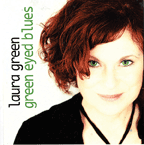 Laura
Green
Laura
Green
Green Eyed Blues
Self-produced 2020
From St. Louis, Missouri, Laura Green has green eyes, red hair, and a
serious case of the blues. A performer for less than a decade, she became
chanteuse for the Green McDonough Band in 2016; the group won regional
awards and progressed to the semifinals of the 2017 International Blues
Challenge. Guitarist Rich McDonough is along for the ride on Green’s
first solo release, which showcases her songwriting as well as singing
skills: all eleven tracks are originals.
The overriding theme and standard blues trope is love: relationships and
their travails. Refreshingly, Green’s lyrics reflect not only the
pain of fraught and dying affairs, but also a definite feminine assertiveness.
An apt example is “Baby No More,” a blues rocker with tasty
backing chorus wherein Green declares that her lover can just walk out
the door, she ain’t taking no more! Similarly, in “All the
King’s Men” she declares “don’t tell me no more
lies now” and emphasizes it with one her most passionate vocals.
On the track, the set’s longest at six minutes, she is supported
by zesty backing vocals, tinkly piano, and a vigorous, high register,
single note guitar solo.
Most of the songs hew to a common format: brief instrumental opening,
several choruses of Green’s strong singing, a long mid-track guitar
solo, and several more choruses reprising the theme.
There are several departures providing variety. “Still in Love,”
a shuffle, sports Green repeating the same word “you” multiple
times so that it becomes an incantation; it reminds one of like efforts
by Van Morrison and Tracy Chapman. “A Reason to Sing the Blues”
deploys extensive use of the guitar wah-wah pedal over a funky groove.
“That’s Right” begins with a stark drum solo and segues
into a neat syncopated beat, with Green’s voicing almost a talking
blues interspersed with extended upper register notes, all placed around
a wild electric guitar solo. “Cry,” features what sounds like
Green effectively overdubbed on her own vocal. Particularly interesting
is “Mama Don’t Cry,” the shortest track but sporting
nice interplay between guitar and Charlie Pfeffer (in his only appearance)
on mandolin.
Green’s ensemble cast comports itself well. Bass is played throughout
by Art Dwyer. Two guitarists besides McDonough are credited, as are two
drummers and four backing vocalists. There are also three keyboard performers
listed; they sound uniformly snappy despite being given no solo time.
Unfortunately, the limited liner notes don’t indicate which musicians
play on which tracks.
Expect to hear lots more from one of St. Louis’ reigning blues singers.—Steve
Daniels
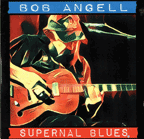 Bob
Angell
Bob
Angell
Supernal Blues
Rawtone Records 2020
The smallest U.S. state by area and one of the least populous, Rhode Island
nonetheless has proved to be a hotbed of quality blues: think Roomful
of Blues, Duke Robillard, Paul Geremia, Sugar Ray and the Bluestones,
the Knickerbocker All-Stars. Less well known but equally steeped in the
blues is guitarist, singer, and songwriter Bob Angell. His music has long
evoked both seminal American country blues and electrified Chicago stylings;
some of the individuals who he cites as major influences include Robert
Johnson, Big Walter Horton, Hubert Sumlin, and John Mayall.
His latest release is an eclectic set of fourteen original tunes, produced
by Robillard, and spanning a gamut of styles. Several musicians are credited
with appearances on one or two tracks; by inference, all the other instrumentation,
including multiple guitar overdubs, is done by Angell.
The set opens with “Immediate Blues,” a mid-tempo shuffle
with dual guitar attack by Angell and Robillard (in his only appearance);
presumably the lead is by Duke, with Angell providing funky rhythm backing.
It’s followed by “Blues Memphis,” Bob’s raspy
vocal accompanied only by himself on slide….which is succeeded by
“If You’re Really Gonna Leave Me,” a slow blues with
Bob crooning, and strumming an acoustic guitar while Robert Marsella adds
haunting harmonica accompaniment reminiscent of Charlie Musselwhite’s
renderings on his classic “Cristo Redentor.” “Drinkin’
Shoes” is Angell delivering a talking blues over his acoustic, and
then Jack Moore on drums and Vinnie Earnshaw on bass join in for the instrumental
“Slo-Pokin’,” Angell wielding overdubbed electric guitars,
one with prominent wah-wah pedal.
You get the idea: variety. Next up is a rocker with Hawaiian guitar effect
in an ode to oral sex, “Eatin’ Ain’t Cheatin,”
then a one minute mid-tempo instrumental interlude, succeeded by the jaunty
“Snake Shakin’ Daddy,” and then another one minute instrumental,
this time sped up: it sounds like the hoary pop instrumental “Tequila”
on acid.
Still to come: a track with a country music flavor (who’s playing
the piano? Bob?), a second Hawaiian instrumental, a double entendre number
with clever lyrics over slide guitar, a shuffle showcasing Marsella’s
harp prowess, and finally the discordant Mississippi hill country blues
track “Lonely Here No More.” The set closes surprisingly with
its only cover, the devotional “Jesus Loves Me,” replete with
piano and high-pitched chorus.
Bob Angell’s vocal cords can produce both grit and grease and his
lyrics are often witty and picturesque. Its positive attributes and its
variety make this an album worth a listen.—Steve Daniels
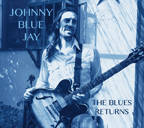 Johnny
Blue Jay
Johnny
Blue Jay
The Blues Returns
Albatross Records
Johnny Blue Jay is an LA based four-piece blues band, driven by guitarists
John Sikora (Johnny Blue Jay) and Jerry Rosen. Sikora handles all the
vocals and the duo co-produced this debut release. Of the thirteen tracks,
eleven are original, mostly written by Rosen, with a couple by Sikora.
The guitarists have been playing together in various bands for over a
dozen years, notably with the Kara Maguire band in the late aughts. Bassist
Greg Imhoff and drummer Sam McAdam joined up around three years ago and
the quartet have been gigging around Southern California ever since. The
guitarists split up the leads fairly evenly as notated in the CD insert.
“Light of Day” is a rocking highlight, with both guitarists
taking turns soloing. Their styles and approaches are similar, as is probably
their influences. The biggest difference being Johnny Blue Jay’s
preference for his semi-hollow Epiphone (featured in beautiful color on
the actual CD) versus Jerry Rosen’s solid body Fender. The rhythm
section of Imhoff and McAdam locks in real nicely on Magic Sam’s
“Easy Baby,” allowing Sikora’s smooth voice to soar
over the proceedings, while Rosen throws in a tasty solo. “The Blues
Ain’t Dead” closes the set, a Chicago style shuffle with a
lyric that maintains that as long as there is misery and financial struggles
among the people, the “Blues” isn’t going anywhere -
true words indeed. The album maintains a laid-back feel throughout, and
simmers when necessary. Overdubs are kept to minimum: a couple of songs
feature Rosen on both lead and rhythm and there’s a great vocal
harmony by Sikora on “Light of Day.” With no intruding horn
charts, keyboards or obligatory guest spots, The Blues Returns is a fine,
lean and accurate representation of the Johnny Blue Jay band as a live
entity. The band is an infant in blues band years (not withstanding Sikora
and Rosen’s history together) and here’s hoping this is just
the start of a long, fruitful journey. – Bob Monteleone
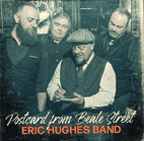 Eric
Hughes Band
Eric
Hughes Band
Postcard from Beale Street
Endless Blues Records 2020
Rooted squarely in the city of his birth, Memphis denizen Eric Hughes
is a renowned fixture on Beale Street, where for years he has had multiple
weekly gigs, solo, as a duo, or with his band. His most current release
showcases the talents which have made him so popular.
Although he sings and plays guitar, perhaps Hughes’ greatest forte
is songwriting. The ten original tracks on this half hour album are all
brief, but they all address common concerns, and with lyrics both direct
and witty. One of my favorites is “Come See About Me,” a slow
ballad with vocal harmonies shared with fellow guitarist (Eric’s
brother) Walter Hughes, and haunting harmonica fills by Eric. His vocal
has a hint of country music twang, characteristic of several of the songs
(and he sounds strikingly like fellow contemporary bluesman Ray Bonneville).
The song is a plaintive plea to his absent lover to return: “there’s
no one I’d rather see… in my dark room/shed some light on
me.” Similarly moving is “Homesick Angel,” again with
beautiful vocal harmonizing and a languorous pace presented over background
rat-a-tat marching drums.
Humor, with a touch of poignancy, is represented by “Oh, Booze!”
which begins with trumpet and saxophone waxing New Orleans-style as Hughes
croons “I got nothin’ left to lose/All I got is the blues/but
what I really want is booze.” Certainly no advertisement for AA,
the song is clever, self-deprecating, rueful, and theatrical, and would
be perfect for the soundtrack of the right movie.
Other themes touched on are perseverance (“Aint Whipped Yet”),
camaraderie and its fragility (“Fair Weather Friends”), nostalgia
for childhood and its simple pleasures (“Blackberry Patch”),
and warning about a treacherous lover (“He’s Just an Alley
Cat”, which sports pounding drums and some shrieking guitar work
reminiscent of Jimi Hendrix’s “Purple Haze”). There
are no extended self-indulgent guitar solos; the songs are the focus.
Hughes’ appealing tenor singing is backed by Leo Goff on bass, Rick
Steff on keyboards, Brian Aylor on drums, and horn players Kirk Smothers
and Marc Franklin, as well as Walter Hughes. On “Follow Your Stupid
Little Dreams” I hear a banjo, but none is credited in the liner
notes
Skilled musicianship and finely crafted songs make for a worthy album
by the Eric Hughes Band.—Steve Daniels
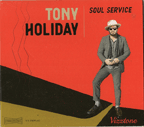 Tony
Holiday
Tony
Holiday
Soul Service
Vizztone 2020
Based in Memphis, singer and harmonica player Tony Holiday entered the
blues arena in 2019 with his eclectic and innovative album, “Porch
Sessions.” The release was just what its title implied: Holiday
applied his talent in tandem with multiple fellow blues artists, recording
tracks in mainly acoustic mode…on their front porches. Guitarist
Landon Stone and producer and bass player Kid Andersen were present throughout;
drums, when used, were handled by several players, including Danny Banks.
On this new release Banks is the sole drum chair occupant, Max Kaplan
replaces Andersen, and a welcome guest is keyboard maven Victor Wainwright.
The set is a sparse half hour long, but sports good sound quality, courtesy
of producer Ori Naftaly, of Southern Avenue, who also adds his guitar
expertise alongside that of Stone. (In a tongue-in-cheek retro gesture,
the set is divided into Side A and Side B…or maybe there is a vinyl
version with actual sides, in addition to my CD product.)
The set has many strengths, not least being Holiday’s vocals. His
tenor renderings are pitch-prefect and smooth on all tracks, and they
especially stand out on “It’s Gonna Take Some Time”
and “Day Dates (Turn into Night Dates),” both of which have
a decided country music vibe. The former is aided by nice backing vocals
by Kaplan and skillful chromatic harp playing by Tony; the latter has
a sweet bass introduction and some sultry, twangy guitar work.
Mixed in are a few shuffles with fine dual guitar interplay; “She
Knocks Me Out” has a particularly terrific guitar lead. “Good
Advice,” the shortest track at two-and-a-half minutes, has clever
lyrics utilizing a host of hoary clichés in a creative manner.
The set concludes with its longest cut, “Ol’ Number Nine,”
which strays into blues rock territory with its driving rhythm section
and some of Holiday’s best diatonic harmonica fills.
Although he is afforded no significant solos, Wainwright’s keyboard
contributions are excellent. Naftaly and Stone acquit themselves well
on their axes; unfortunately, the almost non-existent liner notes don’t
tell us on which tracks they are both playing, or whether one is playing
with overdubs. Track durations are also not provided, nor are song authorships;
are these all originals?
Administrative quibbles aside, it is clear that Tony Holiday has avoided
a second release let-down.—Steve Daniels
Michael Mcdermott
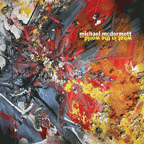 What
In The World...
What
In The World...
Pauper Sky CD
On the other side of addiction, jail and rehab for six years now, McDermott’s
latest may well be his finest, most clear-headed work to date, with 2016’s
Willow Springs which went to Number One on the European/American charts
a close second, as his confessional, story-song lyrics, a la Bob Dylan
or Bruce Springsteen, with memory snatches, incident-tales and personalities
(“three hits are enough”) leave one breathless. What in The
World is a steamroller of emotion and freewheeling textures. Guitars ring
out a la Tom Petty one minute then appease with balmy finger-picking the
next. The title cut, that opens and closes this rewarding project, is
an out-and-out rocker and a politically juiced anthem for this election
year as he snarls about the “new world order, walls along the border,
children in cages and executive orders” while “Blue-Eyed Barmaid”
reverses the roles as the broken but winsome barmaid pours out her troubles
to an unflinching customer. Other stunners include the compelling “Veils
Of Veronica” (“her eyes are like a storm out on the sea”),
a piano-driven “Die With Me’ moves from contempt to revelry
in the face of the current racially charged atmosphere (“all the
scars we seem to carry, well, tonight I’ll set it all afire”),
the candid “Contender” and the optimistic “No Matter
What” (“I was still drinking then”). Other nuggets include
an arresting love song titled “Until I Found You” and the
insightfully surrealistic “Positively Central Park” (“If
you’ll love me for eternity, would you bury me at Wounded Knee”).
Just goes to show you can’t keep a good man down. More please.—Gary
von Tersch
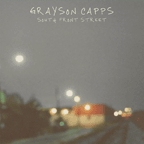 Grayson
Capps
Grayson
Capps
South Front Street: A Retrospective 1997-2019
Royal Potato Family CD
South Alabaman Grayson Capps’ latest is a 16 song recollective of
the heralded songwriter’s career, expertly compiled by his wife
and longtime musical foil, producer and engineer Trina Shoemaker, who
explains: I started this as a personal compilation that I sequenced for
myself. It is a collection of songs that paint a picture of our life together
and reveals a world from the uniquely enchanted, poetic and tormented
perspective of Grayson Capps.” She titles the collection after the
street where Capp lived in a shotgun shack along the Mississippi River
in New Orleans along with an collective of vagrants and ne’er-do-wells
that he credits as the spark for finding his voice as a songwriter. Touching
on tunes written both before and after Capps met Shoemaker, this round-up
encompasses material from his acclaimed blues-rocking band Stavin’
Chain as well as his role in the cult film A Love Song For Bobby Long
starring Scarlett Johansson and John Travolta. Some of his best known
work, “Get Back Up,” “Washboard Lisa” and “Daddy’s
Eyes” seem born again, thanks to Shoemaker’s mixing talents,
while deeper efforts like”Harley Davidson,” “May We
Love” and “Train Song“ also gain more intense musical
traction thanks to Shoemaker. As American Songwriter opines: “Take
the poetry of Texas troubadour Townes Van Zandt. combine with Steve Earle’s
edgy attitude and stir with a little cup of bayou blues (think Howlin’
Wolf) and you start to get a taste of Capps’ scrumptious Southern
Gothic gumbo.” If you like songs that corral a life in motion, in
pain and joy, in gain and loss, in humility and grace look no further.—Gary
von Tersch
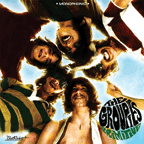 The
Groupies
The
Groupies
Primitive
BeatRocket CD
The Groupies were a garage/psychedelic blues rock band formed in
the Lower East Side of New York City in 1965. The habitually stoned five
man combo, nevertheless, performed regularly at The Scene, a “happening”
New York night club, becoming quickly one of the most trendy live acts
around town—for a while second only to the Young Rascals—and
were signed by Ahmet Ertegun to Atco Records in 1966. This eleven track
project is the band’s complete known recorded work, comprising their
sole Atco single (the iconic and oft-covered “Primitive,”
an assertive rewrite of Howlin’ Wolf’s “Spoonful, with
its equally swaggering B side, a cover of the Coasters’ “I’m
A Hog For You Baby”) along with a histrionic 1967 live show from
Will Rogers State Beach in Los Angeles promoted as a Love-In and including
an over-the-top introduction by the INIMITABLE Kim Fowley. Animatedly
adenoidal lead vocalist and slide guitarist, the ill-fated Cooker, succinctly
describes their uncompromisingly non-commercial musical approach
thusly: “We played gutsy blues stuff. It was very rhythmic. Our
drummer could pound the shit out of it and we just played on top of that.”
The summertime beach concert set reads like a tribute to Chess Records’
songwriter Willie Dixon with totally intense reworkings of blues classics
like “Down In The Bottom,” “You Can’t Judge A
Book By The Cover,” “I’m A Man” and “Goin’
Down Slow.” Also predictably fervid are covers of Ike and Tina Turner’s
“It’s Gonna Work Out Fine,” the Kinks’ “It’s
Too Late” (when it kicks into the chorus, watch out!) and Them’s
“Gloria.” The original “bad boys of rock” in all
their frenzied glory. Play loud!—Gary von Tersch
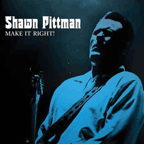 Shawn
Pittman
Shawn
Pittman
Make it Right
Guitarist Shawn Pittman knows that
idle hands are the devil’s workshop. Armed with a mongrel Fender
Telecaster with an Esquire neck, a Jimmie Vaughan Text Mex Strat, a Fender
Bassman and a Super Reverb, Pittman found himself with some time off between
festival shows in Spain and Denmark. Pittman’s then bass player,
Erkan Özdemir, also acting as the band’s tour manager,
recommended they visit Heyman Studios near Copenhagen, where the three-piece,
including Erkan’s son Levent on drums, recorded “Make it Right,” an
album of Pittman originals mixed with some covers. The album includes
classics like “Woke Up Screaming” by Bobby ‘Blue’
Bland, an instrumental version of James Brown’s “Cold Sweat,”
Junior Kimbrough’s “I Feel Good,” Eddie Taylor’s
“There’ll Be a Day” and “Finger on the Trigger”
by Albert King all made it onto the album. Pittman’s originals convey
the vision of hardscrabble wooden floorboards being pounded on the chitlin’
circuit in the 60’s. There are no gratuitous studio tricks here,
everything you hear comes from the pulverized drum kit and the signal
bleeding amplifiers straight into the microphones in the studio. Pittman
skips way back in time past the muddied sounds of early ZZ Top straight
to the heart of Lightnin’ Hopkins, John Lee Hooker and Muddy Waters.
The title track, “Make it Right!”, is a perfect example of
a mid-tempo Junior Kimbrough-style steady drone boogie, played with the
thumb on the bass strings, while attacking the upper register with the
rest of the right hand.
The only evidence that this record is not an exclusively live performance
is when Pittman throws a second guitar track into the mix as on the opening
cut “Done Tole’ You So!” and on the Albert King song
“Finger on the Trigger.” Özdemir’s bass tracks
are recorded with absolutely no high-end frequencies lending the impression
that you are listening to the band in a bar rather than from the engineer’s
booth in a modern recording studio. The drums are similarly vintage sounding,
which increases their emotional menace. Modern blues bands in the studio
tend to articulate every instrument distinctly and shelve their signals
so they don’t interfere with each other – but “Make
It Right!” lets the band bleed into each as though they were in
a bar-room brawl – to a new or younger audience this album may actually
scare them. Often when listening to an album you think to yourself, ‘wow!
I’d like to hear this band live!’ With “Make It Right!”
I venture this is exactly what you’re getting: sweat, drive, pain,
angst, the power, joy, the tears and entreaties of the broken hearted
expressed through metal wires and drums. The more I listen to it –
the more I like it.—Conrad Warre
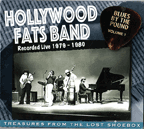 Hollywood
Fats Band
Hollywood
Fats Band
Blues by the Pound – Vol. 1
Topcat Records 2019
There is a well-known movie director named Michael Mann, and a nationally-known
climate researcher by the same name…and then there was Michael Mann,
AKA Hollywood Fats.
Born in Los Angeles in 1954, Fats began playing guitar at ten and within
a few years was jamming with the greats. He toured or played with Albert
King, Jimmy Witherspoon, Buddy Guy, Muddy Waters, and John Lee Hooker,
among others, and was a cog in the smooth machines of The Blasters and
The James Harman Band. (On one of the best nights of my life I saw him
and Kid Ramos ply dual guitars with Harman’s band in the mid-1980s.)
His dazzling career ended abruptly and tragically with his untimely death
in 1986; he was only 32.
Fats’s legacy survives on multiple recordings, most notably “Rock
This House,” recorded in 1979 and released by Black Top Records
in 1991. On that stellar album he was accompanied by bandmates Al Blake
on harmonica and vocals, Fred Kaplan on keyboards, Richard Innes on drums,
and Larry Taylor (of Canned Heat and John Mayall’s Bluesbreakers)
on bass. That lineup, with Junior Watson and Kirk Eli Fletcher on guitar,
subsequently persisted for a time after Fats’ death as the Hollywood
Blue Flames.
Surviving band members Kaplan and Blake have now gifted us with another
full hour of the band in fine form in front of an appreciative crowd in
1979. Most of the set is comprised of covers, although Fats penned three
tunes. Sound quality varies from acceptable to good but is plenty adequate
to appreciate one of the all-time best West Coast (or anywhere!) blues
bands. Innes and Taylor, paired for many years, provided an impeccable
rhythm foundation. Kaplan’s piano mastery was apparent throughout,
beginning with the first track, “Chicken Shack Boogie,” five
minutes of raw power and unwavering energy. Blake added gritty harp, and
vocals with an insinuating Oklahoma drawl; particularly compelling is
his singing on the album’s longest track, “Too Much Jelly
Roll,” a Floyd Dixon composition extended to a nine-minute mid-tempo
shuffle with lascivious double entendre lyrics.
Other highlights include “Okie Dokie Stomp,” memorably also
recorded by Clarence “Gatemouth” Brown, “Nit Wit,”
an instrumental with Kaplan soaring skyward on the 88s, and “Tribute
to T-Bone Walker,” another instrumental demonstrating that the band
could slow the tempo without loss of skill.
Oh, yes, about Fats’ guitar playing…superb! He never over-indulged;
his leads were generally pithy but incandescent, and – most notable
in my opinion – he had an infallible and irresistible sense of rhythm.
The Hollywood Fats Band could rock!
Thank you, Fred and Al for giving us more Hollywood Fats! Can’t
wait for Vol. 2.—Steve Daniels
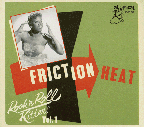
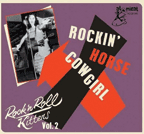
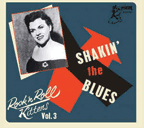
Friction Heat
Rock ‘n Roll Kittens/ Vol 1
Atomicat CD
Rockin’ Horse Cowboy
Rock ‘n Roll Kittens/Vol 2
Atomicat CD
Shakin’ The Blues
Rock ‘n Roll Kittens/Vol 3
Atomicat CD
If you favor your rock ‘n’ roll FAST and FURIOUS, with an
abundance of female “sass” (a la Sarah Vaughan) these three
compilations are right up your alley. Collected from a wide variety of
big and small labels and showcasing knowns and unknowns alike, elements
of swing, country, dixieland, blues, jazz, calypso hillbilly, rhythm &
blues, rockabilly and western swing abound with the sole consolidating
element their undeniable, across the boards, rock ‘n’ rolling
danceability. Particular toe-tapping picks from Volume One include Erline
Harris ragging and bragging about her “Long Tall Papa” as
well as insinuating Rosemary McCoy’s Coasters-like “Dippin’
Is My Business,” Lizzy Miles wailing about her “Salty Dog”
and Etta James raving about her “Tough Lover” a la Little
Richard. Other gems here include titles by Big Maybelle, Etta Jones, Nellie
Lutcher and, believe it or not, Patti Page and Rosemary Clooney. Nuggets
also abound from local unsungs such as Bonnie Lou (“Friction Heat”),
Judy & Joyce (Rock & Roll Kittens”) and the Morrison
Sisters, who can’t make up their minds on “The Rockin’
Boogie Shuffle.” Volume Two is more of the same, book-ended by Wanda
Jackson’s descriptive “Fujiyama Mama” (“I can
cause destruction just like the atom bomb!”) and Patsy Cline’s
easy-loping smash “Walkin’ After Midnight” with great
sides by the likes of Peggy Lee (“Fever”), Varetta Dillard
(“If You Want To Be My Baby”), The Teen Queens (“Red
Top”), Cile Turner (“Crap Shootin’ Sinner”) and
Bonnie Davis (“Pepper-Hot Baby”) in between. Total obscurities
also impress—titles like Dolores Frederick, who wants her man to
“Get A Transfer,” Nita, Rita & Ruby declaring that “Baby,
You’re The One” or Kay Martin telling her fellow to be sure
to “Come By Sunday” all had me pressing the restart button.
Other nuggets feature Pearl Bailey (“You Gotta Dance”) and
Rosemary Clooney’s “Come On-a My House” (written by
William Saroyan.) Volume Three really mixes things up—From Brenda
Lee’s transfixing “Dynamite!’ and Etta James’
testimonial “Good Rockin’ Daddy” to Doris Day’s
“Shaking The Blues” and Betty Hutton’s “Hot Dog!
That Made Him Mad.” Further picks feature a bevy of “Sisters”
performers (The Barry, Davis, Kendall and DeJohn’s) as well as Judy
Faye bragging about her “Plaything,” Jill Corey’s invitation
to “Love Me To Pieces,” Lizzie Miles lamenting that “A
Good Man Is Hard To Find” and had-enough Ella Mae Morse declaring
“I’m Gone.” Other fascinators feature Ruth & Al,
Dolly Cooper, Betsy Gay, Doris Day “Shaking The Blues,” Carol
Jarvis bragging about her “Lover Boy” and Kay Starr’s
calypso-like “Kay’s Lament.” All in all, lots of hot
rockin’ music of all stripes by some tough ladies of early rock
‘n’ roll, black as well as white, that demonstrate that the
distaff side was quite capable of rocking just as HARD as their counterparts!—Gary
von Tersch
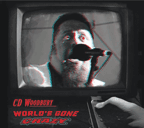 CD
Woodbury
CD
Woodbury
World’s Gone Crazy
Self-Released CD
In 2014, guitarist/vocalist CD Woodbury and his band were dubbed the “Kings
Of Beale Street” at Jerry Lee Lewis’ honky-tonk night-spot
during the combo’s first appearance at the International Blues Challenge
in Memphis. Fast forward to 2020 that saw another well-received performance
at the IBC along with a successful crowdfunding campaign that enabled
Woodbury to bring the band into the iconic Robert Lang Studios in Seattle
to record his quite aurally inviting sophomore effort. The first half
of World is a set of boldly crafted originals, full of acerbic repartee
and imaginative storytelling, followed by adroit arrangements of some
welcome covers—particularly the eight minute, arrestingly earthy
reworking of the sixties chestnut “Hey Joe” as well as the
leaving-town, lazy Chicago shuffling “Last Go Round.” Picks
among the originals include the rocking, tango-vibed “I Didn’t
Know” while the title track opens with some spookily moaning slide
guitar before settling into a greasy, swampy groove with Woodbury offering
some newsworthily cogent reflections on how “a working man survives
in these troubled times.” Woodbury also cleverly stretches out the
twelve bar format on the nostalgic “Emerald City Blues” while
relaying his wayward antics on Beale Street during “Memphis Heat,”
with each band member (Don Montana, Patrick McDanel and Mike Marinig)
getting some soulfully humid solo space. Also noted is Woodbury’s
great Fats Waller improv on the merrily droll narrative concerning dieting,
“Can’t Eat That Stuff No More,” while the band plays
the blues. Recommended.—Gary von Tersch
 Sephaniah
Ohora
Sephaniah
Ohora
Listening To The Music
Last Roundup CD
Produced by the late musical genius Neal Casal, Ohora’s latest collection
coalesces timeless twang with modernistic insights, while recalling the
likes of Harry Chapin, Merle Haggard and Gram Parsons (with a bit of Mickey
Newbury for good measure) as its dozen songs explore an unmistakably urban,
21st century view through a classic country lens, replete with sensational
fretwork, fleet pedal steel and his vivid baritone vocals. Backed by a
razor-sharp band, Ohora’s songs sparkle with dynamism as they move
beyond a throwback revivalism to forge forward in an acclamation of music
and reminiscence that effortlessly spans the thousands of miles between
Bakersfield and Brooklyn. This 12 song project opens with the optimistic,
tone-setting “Heaven’s On The Way” and continues with
ruminative nuggets like the sprightly philosophical “Black &
Blue,” an observational “Riding That Train” (about traveling
on the subway to a gig), the wistfully bluesy “It’s Not So
Easy Today,” the percolating “Time Won’t Take Its Time”
and a fervent commentary on the current political milieu titled “All
American Singer.” A repeatedly rewarding project for big-eared blues
fans.—Gary von Tersch
Books
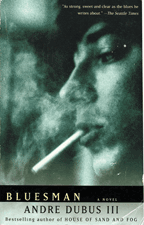
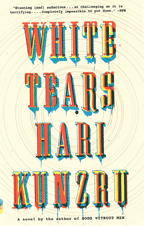 Bluesman: A Novel
Bluesman: A Novel
By Andre Dubus III
Vintage Books 328 pages 1993
White Tears
By Hari Kunzru
Vintage Books 271 pages 2017
There are a myriad of books about the blues, but the great majority are
non-fiction, analyzing the genre or reviewing its history and main purveyors.
However, the blues has also made its appearance in multiple works of fiction.
Two of literature’s lauded contemporary novelists, Ian McEwan and
T.C. Boyle, are apparent blues aficionados who have created characters
fond of the genre. Here are two worthy novels, published a quarter century
apart, about two young white men enthralled and entangled by blues music.
(Interestingly, a search into the lives of the two authors reveals no
evidence that either is a musician.)
Dubus is an acclaimed author of short stories, novels, and a memoir. Bluesman’s
protagonist, Leo Suther, is a seventeen year old denizen of a small town
in western Massachusetts, living with his widowed father Jim, a taciturn
blue collar worker and a skilled slide guitarist. Ryder, Leo’s unofficial
“uncle” and his father’s best friend, is an avid and
adept harmonica player who mentors Leo’s dive into the intricacies
of the blues harp.
As Leo’s ju nior year of high school unfolds he experiences a turbulent
first love affair, some shocking violence, and an introduction into the
political agitation and polarization of 1967, the time of the story. By
the end of the tale he has – quickly and somewhat implausibly -become
an ace player, covering tunes by Mance Lipscomb, Lightnin’ Hopkins,
and Son House among others in a trio with Jim and Ryder.
Bluesman is not a blues novel; instead it fits comfortably into the category
of a coming-of-age story. Unlike Dubus’ later award-winning work,
it suffers from a surfeit of verbiage; there is no need for the reader
to learn of every cigarette, cup of coffee, beer, and meal composition
each character enjoys. I’ll leave it to harp players to decide if
Dubus’s description of harmonica playing is accurate, and/or pretentious:
“Leo bluesed it up in a double-time tempo…he blew out a chord
note, then sucked in for a long fluttering trill he capped with a hand-smacking
pop….He raised the harp again, tongue-blocked a long high wolf-cry
of a note….”
The protagonist of White Tears is almost a decade older than Leo, but
Seth, like Leo, is seeking his place in the scheme of things. Enrapt with
sound technology, Seth records ambient noise and by chance a song by a
blues street busker. His ensuing pursuit of the singer, Charlie Shaw,
with his impulsive buddy Carter, morphs into a saga arguably characterized
as an amalgam of mystery, horror story, and magical realism. Along the
way there is another shocking act of violence, and many of Seth’s
assumptions are rudely disabused.
More skillfully written than Bluesman, White Tears also expands from its
focus on Seth to touch on themes of music commercialization, artistic
authenticity, racial inequality and racism, and especially cultural appropriation.
Seth and Carter are certainly entitled to pursue the lore of African American
country blues, and to honor it for its importance in U.S. culture…but
are they justified in exploiting it for their own personal uses? The novel
provides no definitive answers, but its exploration of the questions is
haunting.—Steve Daniels
Home
/ Blues Blogs /
Artist Links / Blues
Links / Videos / Store
Subscribe / Advertise
/ Back Issues
/ Contact / Staff